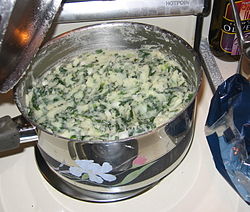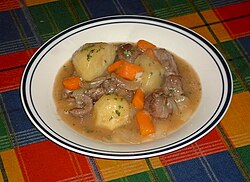Irish cuisine
This article has multiple issues. Please help improve it or discuss these issues on the talk page. (Learn how and when to remove these messages)
No issues specified. Please specify issues, or remove this template. |

Irish cuisine is a style of cooking originating from Ireland or developed by Irish people. It evolved from centuries of social and political change. The cuisine takes its influence from the crops grown and animals farmed in its temperate climate. The introduction of the potato in the second half of the 16th century heavily influenced Ireland's cuisine thereafter. Representative Irish dishes are Irish stew, bacon and cabbage, boxty, coddle, and colcannon.
History



There are many references to food and drink in early Irish literature. Honey seems to have been widely eaten and used in the making of mead. The old stories also contain many references to banquets, although these may well be greatly exaggerated and provide little insight into everyday diets. There are also many references to fulacht fiadh, which may have been sites for cooking deer, consisting of holes in the ground which were filled with water. The meat was placed in the water and cooked by the introduction of hot stones. Many fulacht fiadh sites have been identified across the island of Ireland, and some of them appear to have been in use up to the 17th century.
Excavations at the Viking settlement in the Wood Quay area of Dublin have produced a significant amount of information on the diet of the inhabitants of the town. The main meats eaten were beef, mutton and pork. Domestic poultry and geese as well as fish and shellfish were also common, as was a wide range of native berries and nuts, especially hazel. The seeds of knotgrass and goosefoot were widely present and may have been used to make a porridge.
From the Middle Ages, until the arrival of the potato in the 16th century, the dominant feature of the rural economy was the herding of cattle. The meat produced was mostly the preserve of the gentry and nobility. The poor generally made do with milk, butter, cheese, and offal, supplemented with oats and barley. The practice of bleeding cattle and mixing the blood with milk and butter (similar to the practice of the Maasai) was not uncommon. Black pudding is made from blood, grain, (usually barley) and seasoning, and remains a breakfast staple food in Ireland.
Potatoes form the basis for many traditional Irish dishes. The potato was introduced into Ireland in the second half of the 16th century, initially as a garden crop. It eventually came to be the main food crop of the poor. As a food source, the potato is extremely valuable in terms of the amount of energy produced per unit area of crop. The potato is also a good source of many vitamins and minerals, particularly vitamin C when fresh.
Potatoes were widely cultivated, but in particular by those at a subsistence level; the diet of this group of this period consisted mainly of potatoes supplemented with buttermilk. Potatoes were also fed to pigs, to fatten them prior to their slaughter at the approach of the cold winter months. Much of the slaughtered pork would have been cured to provide ham and bacon that could be stored over the winter.
Fresh meat was generally considered a luxury except for the most affluent until the late 19th century and chickens were not raised on a large scale until the emergence of town grocers in the 1880s allowed people to exchange surplus goods, like eggs, and for the first time purchase a variety food items to diversify their diet.
The adoption of the potato as the core of Irish cuisine should not be seen as a voluntary choice. As a result of the Penal Laws (Ireland), the large Irish Catholic majority were denied the right to buy land or to pass it on as they wished to their descendants. Consequently farms became smaller and smaller as the population of Ireland ballooned in the early 19th century (8 million in 1840 compared to 20 million for England, Scotland and Wales combined at the time). Many "farms" were less than a quarter of an acre, which had to provide food for a family of as many as 8 people for a year. The only way to avoid starvation was to intensively cultivate a single crop, the potato, as this crop provided much of the basic nutrition requirements, and so became the only "choice" available to the rural Catholic poor, who formed the vast bulk of the population.
The reliance on potatoes as a staple crop meant that the people of Ireland were vulnerable to poor potato harvests. Consequently several famines occurred throughout the 16th and 17th centuries. The first Great Famine of 1739 was the result of extreme cold weather but the famine of 1845 to 1849 (see Great Irish Famine) was caused by potato blight which spread throughout the Irish crop which was comprised largely of a single variety, the Lumper. Nearly 1,000,000 people died and another 2,000,000 emigrated, and some 3,000,000 people were left destitute.
Modern era
In the 21st century the usual modern selection of foods common to Western culture has been adopted in Ireland. Common meals include pizza, curry, Chinese food, and lately, some West African dishes and East European (especially Polish) dishes have been making an appearance, as ingredients for these and other cuisines have become more widely available.
In tandem with these developments, the last quarter of the 20th century saw the emergence of a new Irish cuisine based on traditional ingredients handled in new ways. This cuisine is based on fresh vegetables, fish (especially salmon and trout), oysters, mussels and other shellfish, traditional soda bread, the wide range of cheeses that are now being made across the country, and, of course, the potato. Traditional dishes, such as Irish stew, coddle, the Irish breakfast, and potato bread have enjoyed a resurgence in popularity. Schools like the Ballymaloe Cookery School have emerged to cater for the associated increased interest in cooking.
Fish and chips take-away is popular. The first fish and chips were sold in Dublin in the 1880s by an Italian immigrant from San Donato Val di Comino, Giuseppe Cervi. His wife Palma would ask customers "Uno di questa, uno di quella?" This phrase (meaning "one of this, one of the other") entered the vernacular in Dublin as "one and one", which is still a common way of referring to fish and chips in the city.[1]
The proliferation of fast food has led to increasing public health problems including obesity, and one of the highest rates of heart disease in the world[citation needed]. Government efforts to combat this have included television advertising campaigns and education programmes in schools[citation needed].
Common foods
- Grains: wheat, oats, barley
- Vegetables: potatoes, tomatoes, cabbage, curly kale
- Dairy: milk, butter, buttermilk, cheese (Gubbeen Cheese, Ardrahan, Corleggy, Durrus, Cashel Blue, Cooleeney)[2]
- Meat: beef, lamb, mutton, chicken, offal, geese
- Seafood: fish, shellfish, smoked salmon, prawn, lobster
Traditional foods


- Breads
- Barmbrack - a kind of sweet bread
- Blaa
- Goody - a dessert dish
- Soda bread
- Wheaten bread
- Pork dishes
- Bacon and cabbage
- Coddle - main ingredients: pork sausages, back bacon and potato
- Crubeens - pig's trotters
- Skirts and kidneys - a kind of pork stew
- Potato dishes
- Boxty - a kind of potato pancake
- Champ - main ingredients: mashed potato, scallions, butter and milk
- Colcannon - main ingredients: mashed potato, kale or cabbage, and butter
- Seafood
While seafood has always been eaten by Irish people, shellfish dishes have increased in popularity in recent times; common examples include Dublin Bay Prawns, oysters (many oyster festivals are held yearly around the coast where oysters are often served with Guinness, the most notable being held in Galway every September) as well as other crustaceans. An example of an Irish shellfish dish is Dublin Lawyer (lobster cooked in whiskey and cream). Salmon and cod are perhaps the two most common types of fish used. Carrageen moss and Dulse (both types of red algae) are commonly used in Irish seafood dishes.
- Others
- Drisheen - a kind of black pudding
- Irish breakfast or Ulster fry[3][4]
- Irish stew - a kind of lamb or mutton stew
Traditional beverages

- Alcohol
- Whiskey (particularly pure pot still whiskey)
- Guinness
- Irish coffee
- Irish cream
- Irish mist
- Mead
- Poitín
- Others
Notable Irish chefs
See also
{{{inline}}}
Notes
- ^ Hegarty, Shane (3 November 2009). "How fish and chips enriched a nation". The Irish Times. Dublin, Ireland. p. 17.
- ^ Davenport 2008, p. 66
- ^ "Today Show Irish Breakfast". MSNBC. 2009-03-17. Retrieved 2010-09-21.
- ^ "Irish Breakfast at". Foodireland.com. Retrieved 2010-09-21.
References
- Davenport, Fionn (2008), Ireland, Lonely Planet, ISBN 1741046963
- Mitchell, Frank and Ryan, Michael. Reading the Irish landscape (1998). ISBN 1-86059-055-1
- National Museum of Ireland. Viking and Medieval Dublin: National Museum Excavations, 1962 - 1973. (1973).
